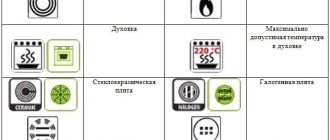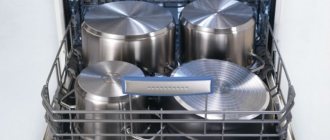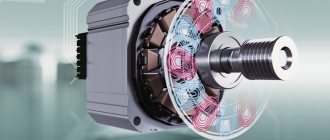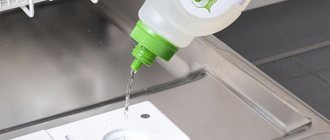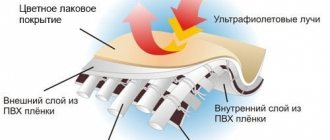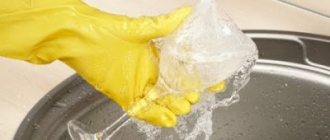The baking tray can be washed in the dishwasher. Of course, if it fits there. All machines cope well with heavy soiling, you just need to place the dishes correctly and select the appropriate settings. On some dishwasher models this is easier and more convenient, since the kit includes attachments suitable for cleaning large baking sheets and frying pans.
Is the baking tray dishwasher safe?
For modern housewives, dishwashers are as familiar an element of the kitchen environment as a refrigerator or microwave. The owners of this miracle technology have adapted the dishwasher to wash any kitchen utensils. But nevertheless, the question often arises, is it possible to wash the baking sheet in the dishwasher? As practice shows, if you use the space in the sink wisely, you can wash everything, including baking trays and hood filters.
What's going on inside
All dishwashers operate according to a specific program. By pressing the button you can enable:
- water supply through a pump;
- heating it;
- washing under rotating jets of water;
- rinsing with a special composition.
Washed dishes are also dried inside. In one step, the unit can clean up to 14 sets of dishes.
https://youtube.com/watch?v=Yao9tLP0nxs
https://youtube.com/watch?v=Yao9tLP0nxs
Detergents
There is a container for detergent on the door of the household appliance. It is impossible to remove stains without using a powder or tablet. And the machine is configured to work with detergents. Without them, the device may automatically turn off. Each type of dishwasher has its own product.
At the bottom of the device there is space for regenerating sodium salt. It will help soften tap water and clean cutlery.
Water temperature
On the electronic control unit, sensors control the temperature of the water inside. A special meter supports the operating mode of the unit. In addition, the sensor ensures that the heating element does not overheat. Optimally, water is heated to 50-60 degrees. Sensors also determine the hardness of the water, the presence of impurities in it, and even the air temperature in the kitchen.
Prolonged exposure to moisture
You can clean dishes until they shine only in several stages:
- First, soak the items so that dried dirt can be washed off.
- The cutlery is thoroughly washed with jets of hot water, which is supplied through the spray nozzles.
- At the end, rinsing with clean water and drying occurs.
The duration of action of water depends on the selected operating mode of the machine and the composition of the soil on the dishes.
Dishwasher Bosch
It should be noted that owners of Bosch dishwashers are lucky. Because the manufacturer took care of equipping the device with special nozzles for washing large flat products. To wash a baking tray or hood filter in a dishwasher, you must correctly position the contaminated elements in the unit’s tank. It is recommended to place the baking sheets on the sides of the basket in a vertical position.
Article on the topic: How to choose a dishwasher for a restaurant
For high-quality rinsing of detergent, there is a special place on the back wall of the unit for fixing the rinsing nozzle. The nozzle is a shower-style water spray. This attachment must be installed before loading dirty dishes. After placing the baking sheets in the Bosch dishwasher tank, do not forget to pour detergent into the compartment.
Next, how to wash a baking sheet in the dishwasher? After loading the dirty elements, detergent and installing a special water spray nozzle, you can start the unit. Usually there are no difficulties with choosing a program and launching it. If you have questions, it is recommended to look at the Bosch operating instructions.
Why did the baking tray remain dirty?
Below you can find warnings that will help you not to spoil the washing process:
- Do not fix the pan diagonally. This will block the sprayer - and the dishes are unlikely to be washed well. Some areas will remain dirty.
- The quick wash mode is not suitable for cleaning these types of dishes. It is better to choose normal or intensive mode. This way you can make cleaning much more effective.
- It is better to use exactly as much detergent as necessary, without skimping or sparing chemicals.
Washing in other dishwashers
If the housewife has a dishwashing unit from another brand, is this dishwasher suitable for baking sheets? According to experienced housewives, you can wash the baking sheet from the oven in any dishwashing machine.
It is only important to choose the correct placement of the product.
- If the dishwasher tank is large, you can arrange the baking trays in the same way as in a Bosch unit. That is, vertically near the side walls.
- If the dimensions of the tank do not allow this, the contaminated element can be placed horizontally, bottom up, on the lower basket.
- As a last resort, the baking sheet can be placed in the same way as a housewife usually places pans for washing in the dishwasher.
Washing a baking tray in a machine
A few nuances
Washing baking sheets in the dishwasher does not end at the stage of placing the element in the tank. It is important to choose the correct operating mode of the unit and the optimal number of rinses. Typically, baking sheets are washed at the same temperature as pans - 65 0 C. If the dishes were used for baking fish, with the addition of sour cream or other fatty sauces, it is important to thoroughly wash all the fat from the surfaces. To prevent the aroma of fish from remaining in the dishwasher, you should additionally select a rinse mode for heavily soiled dishes.
Article on the topic: What does a fully built-in dishwasher mean?
About the detergent
Pans of any size can be washed in the dishwasher. For high-quality washing of grease and dirt, it is recommended to choose the right detergent.
In stores you can find products in the form of:
- Powder.
- Tablets.
- Gels.
Types of detergents
Each housewife chooses the product at her own discretion. However, it must be remembered that tablets are more convenient for use. Each tablet contains the required amount of detergent. The owner only needs to load the tablet into a special compartment and start the unit. For high-quality rinsing and drainage of water from dishes, special rinsing agents should be used. They can also be purchased at any household chemical store.
Once again about inappropriate use
The main thing that absolutely cannot be washed in a PMM is utensils made of aluminum, copper, tin, cast iron, wood and some types of plastic. The rest is permitted without restrictions or with certain reservations.
The dishwasher has several operating modes with different water temperatures. For example, thin glass and porcelain are best at settings of +40–50 C. There is no need to risk washing them at higher temperatures. They may crack
It is not recommended to wash clay pots without glaze in PMM. They will not crack, but will gradually become saturated with substances from washing tablets and liquids. With further use, moisture will come out of the porous clay, and the chemicals will remain inside. The consequences in the form of an unpleasant odor are unlikely to please anyone.
The dishwasher is a great place to sanitize dish sponges. Hot water not only cleans kitchen accessories, but also rids them of germs.
The following article will introduce you in detail to the rules of operating a dishwasher, which is worth reading for both future and “present” owners of useful and convenient household appliances.
Can baking sheets be washed in the dishwasher?
Housewives who have recently acquired a “home assistant” are interested in whether the baking tray can be washed in the dishwasher.
In fact, there are no problems here. If the size of the washing chamber allows you to accommodate the baking sheet, then it can be washed without difficulty. Some dishwasher manufacturers even include special attachments for washing baking sheets and large frying pans, so don’t be afraid to wash them in the machine. In any case, machine washing must be carried out correctly. How? We will talk about this now. Article on the topic: Where is the heating element in the Ariston dishwasher
What can you wash?
Having understood that you cannot wash in the dishwasher, you need to decide what you can wash in it. Based on this, it is advisable in the future to use mainly dishes from this list so that the dishwasher does not sit idle most of the time.
Earlier it was said about crystal. But almost everyone around us washes wine glasses, glasses, glasses, glasses made of this glass in the car. So, can crystal glassware be washed in the dishwasher? Mostly yes. The ban applies only to thin crystal. In this case, it would be a good idea to familiarize yourself with the pictograms on the packaging and look for the permission icon there. If the box has not existed for a long time, then evaluate the quality of workmanship on your own and make an appropriate decision.
Stainless steel is absolutely indifferent to detergents and temperatures, so dishes made from it can be used in the car without restrictions.
Ceramic products. Apart from special modern dishes made to be washed in a machine, ceramics withstand the harsh conditions of a machine better than all other materials. The only thing you need to do is make sure that the plates do not touch each other.
Plastic dishes. Today it takes up the lion's share of all the dishes in the kitchen. These can be plates, mugs, containers, forms. You can have different attitudes towards such a material as plastic, but it is simply ideal for washing in a car. Perfectly withstanding temperature and chemicals, such utensils will also remain unharmed by impacts and contacts.
Baby bottles made of plastic, which are the majority of them today, can be washed under one condition. It is necessary to make allowance for the fact that this is children's dishes. This means that it should be washed with minimal use of chemicals. This can be achieved either simply by not adding any product, or by using a special product designed for children's dishes.
Pans can also be washed in the dishwasher. These are the ones you most often don’t want to wash with your hands. However, it is still better to make sure that there is a corresponding pictogram on the packaging of the frying pan. And it is better to rinse a frying pan that is too greasy in the sink first, since grease has a detrimental effect on the filter of the machine.
What to put in and how to wash?
Many housewives had and still have to wash greasy baking sheets with their hands. This is a very tedious task. Firstly, burnt fat does not come off easily, and you have to scrape the metal with a special plastic scraper to remove it. Secondly, for hand washing, the baking sheet must be placed in the sink so that greasy drops do not fly to the sides, and it is difficult for it to fit there. In general, washing such large dishes is an unpleasant and tedious task, so the dishwasher in this situation will act as a “magic wand”.
- The dishwasher will clean the pan much more thoroughly.
- The dishwasher will take a long time to wash the baking sheets, but there will be no manual labor.
- The dishwasher cleans without mechanical impact, which means that the special non-stick coating of the pan will not be damaged.
Even a relatively safe plastic scraper, which removes burnt-on fat, will eventually damage the coating of the baking sheet, let alone abrasive detergents and brushes.
The baking sheet will take up a lot of space in the dishwasher, but you don't have to wash it alone. Place a large frying pan, a saucepan, a hood filter, a duck roaster, and cutlery in the washing chamber. If you put it all together correctly, the result will be amazing. Let's begin.
- First you need to remove the top basket. In machines with an upper cutlery tray, you may have to remove it if the baking tray will not fit.
- On Bosch dishwashers, there are special grooves on the back wall on the inside of the washing chamber into which nozzles for washing baking sheets are inserted. We insert them.
- We place the baking sheets vertically in the lower basket and lean them against the side wall of the washing chamber.
- Place other dishes in the middle of the basket. If you have somewhere to put cutlery, you can load them too.
- Add the detergent and close the dishwasher door.
- Select the normal program with “Pre-soak”, if available. If there is no “Pre-soaking” mode, then it doesn’t matter, everything should be washed without it.
- We wait for the washing to finish and evaluate the result.
Article on the topic: Where are hansa dishwashers assembled?
Why didn't he wash himself off?
There are many housewives who blame the dishwasher, saying that it washes baking sheets and pans very poorly. Moreover, they almost always back up their words with photographs showing poorly washed baking sheets. When you start asking questions about how they laid out the baking sheets, what detergents they used, what programs they turned on, childhood mistakes pop up. Now we will discuss them.
- Never place a baking sheet horizontally in the dishwasher basket. Firstly, water will accumulate in it, and the machine may freeze in the middle of the wash. Secondly, the baking sheet simply won’t wash well.
- Do not place the tray vertically diagonally from corner to corner of the washing chamber. This way you block the sprinklers and prevent water mixed with detergent from reaching the most contaminated areas of items.
- Do not turn on the quick wash mode. It is better to activate the normal or intensive washing program, this will improve the quality of washing.
- Don't skimp on detergents. Use a whole tablet, not half, or a dose of powder strictly according to the norm. It depends on what you use.
If you are sure that you are doing everything according to the rules, but the machine still does not wash the trays satisfactorily, then you need to contact a dishwasher repairman. Apparently there is some kind of malfunction.
What is the best way to wash?
Separately, I would like to note the fact that very often the dishwasher does not wash baking trays and other dishes “at full strength” because the owner has chosen the wrong detergent. There are a lot of publications on the Internet on the topic of preparing homemade dishwashing detergents in a machine. In an effort to save a few tens of rubles, people simply “went crazy.” They pour soda, mustard, and citric acid into the machine, and then complain that their “home assistants” don’t wash dishes well and sometimes even break.
Article on the topic: How many liters does a dishwasher use?
When it comes to home remedies, experts are adamant. They reasonably believe that only certified powders, capsules and tablets can be used along with special salt and rinse aid. Only with such products can you achieve an acceptable washing result from your machine. It is best to buy those products that are recommended by the manufacturer of specific brands of dishwashers . This means that the products have been tested in interaction with specific “home assistants” and have given excellent results. Treat your equipment with respect, and it will respond to you with long and flawless work.
So, we managed to figure out how to properly wash baking sheets and other similar dishes in the dishwasher. We looked at specific mistakes housewives make when machine washing baking trays and looked at what should be used to wash dishes in the dishwasher, and what should not be used to wash them. We hope the information we provide will be of practical help to you. Good luck!
What will happen to the electrical appliance?
Some dishwasher owners use their “home assistants” to the fullest. It’s amazing how they come up with this idea. Washed in the dishwasher:
- garden tools;
- rubber boots;
- raw root vegetables (mainly potatoes and carrots);
- plastic massage devices;
- chandelier details;
- elbow and knee pads;
- boxing gloves and mouth guards;
- helmets and leather gloves;
- umbrellas;
- flower pots and much more.
Exotic lovers even manage to cook food in the dishwasher.
If they even think about cooking food in a dishwasher, then why condemn those who think of stuffing electrical appliances into the washing chamber, in this case an electric kettle. From the point of view of experts, this should under no circumstances be done. There is a certain amount of electrics inside the kettle: a switch, an LED, several contacts, wires, a sensor. After washing the kettle in the dishwasher, we get this electric thing very wet.
Supporters of non-standard use of a dishwasher may reasonably note that the kettle can be thoroughly dried before use. That’s true, but when washing dishes, the kettle stays in a humid and warm environment for a long time. When exposed to moisture and detergents, metal contacts become covered with oxides, which can cause the kettle to fail.
Moisture can be removed by drying, but oxides can only be removed by cleaning the contacts. If after washing it is possible to completely disassemble the kettle, clean its contacts and carry out anti-corrosion treatment, then you can wash it. But if you do not intend to disassemble the kettle, then it is better not to put it in the dishwasher.
If the body of the kettle consists of plastic or ceramics, this is one thing, but if the kettle is metal, then corrosion can also affect the body. In this case, there is a high risk of losing the kettle. Don't take risks, clean electric kettles by hand.
What is the best way to clean a kettle?
Many housewives say that the best way to clean a kettle from various internal contaminants, including scale, is to boil with citric acid. This is done very simply. Pour water into the dirty inside of the electric kettle (you need to fill the kettle almost full). Next, pour 25 grams of citric acid into the water and bring to a boil 2-3 times. The dirt will come off immediately, but the scale will become brittle and partially come off. We remove the remaining scale with a cloth, on which you need to sprinkle a little lemon and get a clean kettle.
Knives and tools with sharp edges
Sharp objects are contraindicated in the dishwasher. Firstly, you can forget or simply not know about cutting objects, if you were not the one who put the dirty dishes, and get seriously injured.
Secondly, such washing can ruin good appliances. Strong detergents, when used frequently, will dull the sharp edges of expensive knives over time. This is especially true for ordinary housewives who are not often puzzled by sharpening. Knife handles can be damaged in the dishwasher, and carbon steel blades can rust over time.
Article on the topic: What kind of water does the dishwasher connect to?
Thirdly, carelessly placed knives can simply damage the parts of the dishwasher, which will lead to breakdown.
All this, of course, does not apply to ordinary table knives, but their steel inevitably becomes dull over time due to frequent washing.
Brief guide
In conclusion, we will briefly answer the most frequently asked questions on the popular topic “is it dishwasher safe”: the questions were selected based on the frequency of mention in search engines, so the list is, of course, not complete. Sorted alphabetically.
| Aluminum | Categorically “no” - the coating will peel off, the dishes will be covered with a disgusting dark gray coating |
| Bamboo | This is an ordinary tree, so it's not worth it |
| Banks | Glass, of course, can be washed, but there should be no stickers on the jars; or then thoroughly rinse the spray nozzles and clean the drain filter from any remaining paper. |
| Blender | It may suffer the same fate as a meat grinder: the coating will come off |
| Hood | Your desire is understandable: it is impossible to wash the hood grates by hand. But, most likely, it has some kind of coating that will peel off in the dishwasher. |
| Clay | Not worth it for the same reason: it will crack |
| Tree | It’s better not to: it will swell and crack. However, if we are talking about not the most valuable “consumables” like a cutting board, then please. |
| Toys | Made of plastic - we don’t recommend it; with glued parts - of course not. |
| Pots | Depends on the material and coating: stainless steel - no problem, with the rest you need to be more careful and study the icons on the dishes |
| Ceramics | Not recommended: may crack due to temperature changes |
| Containers | It’s not worth it, especially if they are thin-walled: they may warp. If it's made of heat-resistant plastic, please. |
| Bone | We do not recommend: they may crack |
| Cupronickel | It may darken from exposure to chemicals, however, it darkens anyway. Here the opinions of housewives are divided: those who regularly clean cupronickel dishes do not see anything wrong with washing them in the dishwasher |
| Multicooker | Depends on the material of the bowl: if the bowl is made of aluminum - no, with a non-stick coating - it is better to look for the permitting symbol. As for other parts of the multicooker, you should not put plastic and rubber parts into the dishwasher. |
| Meat grinder | No: modern meat grinders are usually chrome plated, and it is guaranteed to come off |
| Stainless steel | No problem! |
| Knives | It is better to avoid: firstly, they are too sharp and can damage machine parts, and secondly, hot water will dull them. |
| Plastic | Thin - no (disposable tableware, containers), with a pungent "chemical" smell - definitely no. You can definitely wash dishes made of heat-resistant plastic; you need to study the icons for other dishes. |
| Shelves | If they have metal parts, then a categorical “no” - the coating will come off |
| Baking tray | It depends on what it is made of: the non-stick coating may suffer over time. But here it is more important to resolve the issue with the capacity of the PMM: not everything will fit into a large baking sheet. |
| Silver | It's better not to risk expensive dishes: silver is a soft metal and may not withstand washing conditions, especially if there is a delicate pattern. |
| Silicone | It withstands dishwasher conditions well, but some housewives complain that baked goods are difficult to come off afterwards |
| Frying pans | Basically it is possible, but there are restrictions: aluminum is definitely not allowed (the coating will come off), cast iron is undesirable (it will begin to rust), Teflon is questionable (the coating may be damaged) |
| Grater | We do not recommend: firstly, it has sharp edges and they can damage machine parts, secondly, many of them have a coating that can peel off, thirdly, numerous food debris will clog the spray nozzles and drain filter, and, most importantly, , the dishwasher still won’t wash food out of small holes. |
| Thermal mug | Like any other vacuum item, it’s not worth it, as you can damage the gaskets, which create this very vacuum. |
| Thermos | You shouldn’t take risks, otherwise the insulating gaskets may be damaged, and the thermos will become poorly kept warm |
| Tefal | In principle, it is possible, but the coating may be damaged: see the icons on the dishes |
| Porcelain | We don’t recommend it: it’s too delicate, and the gilding and painting can noticeably fade |
| Faience | Like porcelain, we do not recommend |
| Crystal | It’s better not to wash it: it may become cloudy and become covered with microcracks. |
| Cast iron | Cast iron cookware may begin to rust |
| Enamel | It is possible, but with reservations: the washing temperature should not be too high and it is better to use milder detergents. Do not forget also that the painting on the dishes will suffer over time under any washing conditions. |
Utensils made from unsuitable metal
The only metal that is 100% dishwasher safe is stainless steel. It is difficult to damage and will not rust.
Cookware made of cast iron or carbon steel quickly rusts from water. That is why it is recommended not to wash cast iron cauldrons and frying pans at all, but simply wipe them thoroughly with a cloth. Enameled cookware can be washed in the dishwasher, but over time this can also damage the enamel.
Don't put aluminum cookware in the dishwasher: it will become dull and blackened, with dull white dry spots. Aluminum is one of the softest and most “responsive” metals; it reacts not only with alkalis and acids, but also with water. To prevent this, manufacturers coat it with a protective oxide layer. But dishwasher detergents contain phosphates, which can destroy the coating. This does not make the food harmful, and the dishes can be used, but they will look unsightly and will last less.
Metals that are prone to tarnishing (copper and brass) are also best not used in the dishwasher. At a minimum, they will lose their shine when exposed to harsh detergents.
Article on the topic: Where is the pressure switch in the dishwasher?
Do not put non-stick pans in the dishwasher. Residues of food can be easily removed from such a surface with a regular damp sponge, and the non-stick layer can be easily damaged in a machine.
What you can't put
Not all kitchen utensils are dishwasher safe. A unit that is not used correctly will quickly become unusable. Not to mention damaged items.
Aluminum, silver and copper cookware
Aluminum is one of those materials that darken after exposure to hot water and powder. A disposable wash will not spoil the appearance of the pot or cutlery. But after 3-4 washes you will have to clean the plaque with other means.
Wooden and cast iron objects
Wood products tend to swell in hot water. Long stays in the dishwasher result in cutting boards, rolling pins, and wooden spoons becoming cracked. After washing in the unit, they will have to be thrown away.
A cast iron cauldron cannot be washed in a household machine. After prolonged exposure to hot water and aggressive detergents, cast iron will begin to corrode. Over time, problem areas will begin to increase, and you will have to part with the dishes.
Knives, strainers and garlic presses
The sharpness of the knife decreases after washing it in hot water. Devices with glued handles do not tolerate soaking. The same applies to horn and bone knife handles.
Strainers can scratch glass and stainless steel surfaces. Do not put a garlic press in the PMM, since it is usually made of aluminum or copper.
Thermos and crystal products
When purchasing a thermos or thermal mug, pay attention to whether they can be washed in a machine. If not, it is better to wash the devices manually
Teflon coating
Teflon-coated cookware should not be overheated. The action of the detergent will damage the coating. After this, it will be impossible to use the expensive device.
Multicooker cups
High temperatures inside the PMM have a negative effect on the non-stick properties of the multicooker bowl
After washing the unit, you will need to use the cooking appliance several times carefully.
Utensils with decorative elements
Increased sensitivity to external influences of unique porcelain and glass products will lead to their loss. Often, heating causes cracks to appear on surfaces and decorations, which will ruin the appearance of the decorative item.
Can the baking sheets be washed in the dishwasher?
Finally, I will become the happy owner of a PMM.:love:I was puzzled by the choice, but it turns out that not all PMMs have attachments for baking sheets, and I bake often:019:I chose Bosch - there are no attachments and you can’t wash without attachments? I also liked Neff ,But I don’t know what kind of company it is. Yes, and some functions are very important or not? For example, pre-rinse - how important is it? Tell me, please
rinsing (separate from programs) is very important, otherwise your PMM will turn into a garbage can with a smell. What kind of attachments are they? if you want to wash baking sheets, just make sure that the top basket of the dishwasher is completely and, most importantly, easily removed (usually there are plastic latches there) - then the baking sheet will fit in height. and wash them on the program for pans - usually 65 degrees
I didn’t understand about the baking sheets... More precisely, about the special attachments. PMM is already six years old, but narrow (60cm). Ariston. The baking sheets don't fit there. You can stuff the gas stove grate (half) in, wash it periodically. I use a preliminary rinse if I put something smelly in the PMM (for example, after sour cream, it “chokes” in the machine), but I’m not going to wash it immediately. From my point of view, this is a necessary function. I only use standard washing and rinsing; we don’t use others (quick wash, for example)
Article on the topic: How to properly connect a bosch dishwasher
60 cm - narrow? what is wide then?))
60 cm - narrow? what is wide then?))
mixed up :046:. not 60, but 45 cm narrow
I couldn’t get the baking sheets in. I haven’t thought of eating the top basket in six years :)), I’ll have to try it. But it seems to me that there is not much point in washing them in PMM, because... If something is badly burnt, it still won’t wash off.
mixed up :046:. not 60, but 45 cm narrow
I couldn’t get the baking sheets in. I haven’t thought of eating the top basket in six years :)), I’ll have to try it. But it seems to me that there is not much point in washing them in PMM, because... If something is badly burnt, it still won’t wash off.
:))It’ll just wash off. I don't even scrape off any leftover food from them if they haven't come off that way. Everything is washed away :love:
I have a narrow 45 cm one - the baking sheets fit. The upper basket lifts up, but does not come off at all. Sometimes my husband just puts a baking sheet on top of the plates :)) - everything is clean.
We turn on the rinse, for example, after lunch we loaded the dishes, rinsed them, and left them until dinner. In the evening everything was washed
Over the 4 years of using BOSCH with a separate rinsing program, I started it 2 times and only 1 time by accident. Perhaps because dishes usually don’t sit there for more than a day. But sometimes I can forget)) - then I’ll just remember - I immediately launch the usual washing program)) By the way, out of 5 pcs, I use one
